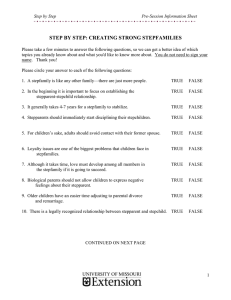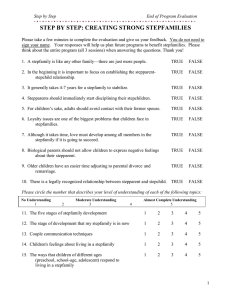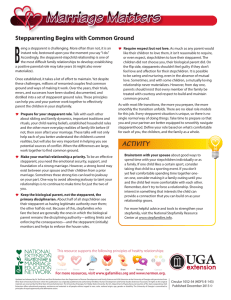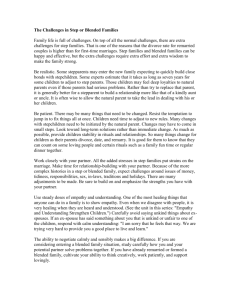Good News for Stepfamilies
advertisement
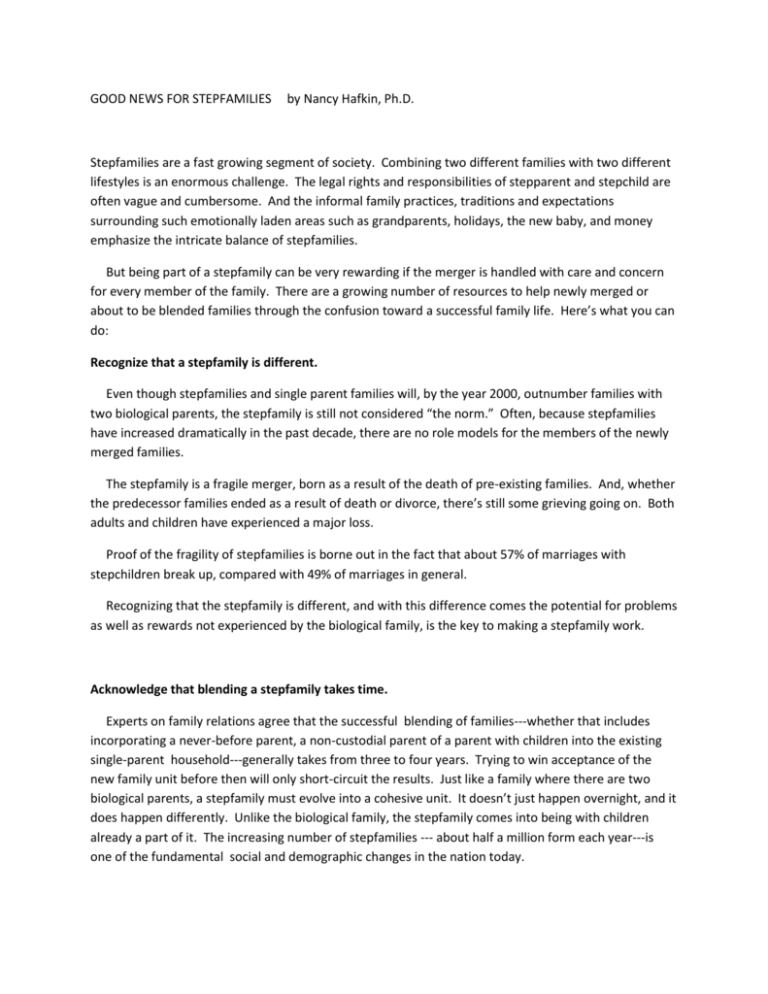
GOOD NEWS FOR STEPFAMILIES by Nancy Hafkin, Ph.D. Stepfamilies are a fast growing segment of society. Combining two different families with two different lifestyles is an enormous challenge. The legal rights and responsibilities of stepparent and stepchild are often vague and cumbersome. And the informal family practices, traditions and expectations surrounding such emotionally laden areas such as grandparents, holidays, the new baby, and money emphasize the intricate balance of stepfamilies. But being part of a stepfamily can be very rewarding if the merger is handled with care and concern for every member of the family. There are a growing number of resources to help newly merged or about to be blended families through the confusion toward a successful family life. Here’s what you can do: Recognize that a stepfamily is different. Even though stepfamilies and single parent families will, by the year 2000, outnumber families with two biological parents, the stepfamily is still not considered “the norm.” Often, because stepfamilies have increased dramatically in the past decade, there are no role models for the members of the newly merged families. The stepfamily is a fragile merger, born as a result of the death of pre-existing families. And, whether the predecessor families ended as a result of death or divorce, there’s still some grieving going on. Both adults and children have experienced a major loss. Proof of the fragility of stepfamilies is borne out in the fact that about 57% of marriages with stepchildren break up, compared with 49% of marriages in general. Recognizing that the stepfamily is different, and with this difference comes the potential for problems as well as rewards not experienced by the biological family, is the key to making a stepfamily work. Acknowledge that blending a stepfamily takes time. Experts on family relations agree that the successful blending of families---whether that includes incorporating a never-before parent, a non-custodial parent of a parent with children into the existing single-parent household---generally takes from three to four years. Trying to win acceptance of the new family unit before then will only short-circuit the results. Just like a family where there are two biological parents, a stepfamily must evolve into a cohesive unit. It doesn’t just happen overnight, and it does happen differently. Unlike the biological family, the stepfamily comes into being with children already a part of it. The increasing number of stepfamilies --- about half a million form each year---is one of the fundamental social and demographic changes in the nation today. By acknowledging that blending a stepfamily takes time, and by being willing to take the time, learn, and keep an open mind, the stepfamily stands a much better chance of becoming a strong, cohesive unit. Discipline carefully. Because each family has its own style of discipline, the blending of stepfamilies has potential for conflicts of style in a very emotional arena. In most cases, children in a stepfamily, understandably, have difficulty accepting the stepparent’s style of discipline. Add to this differing style a differing attitude toward discipline on the part of the parents, and there is the possibility of upsetting the delicate stepfamily balance. Naturally, children have been conditioned to respond to the discipline of their biological parent, and they may react negatively to discipline meted out by the stepparent. This negative response may range from ignoring the stepparent to outright hostility. Children often view the stepparent as interloper, only to be tolerated. This “tolerance” is extended only as long as the stepparent doesn’t “make waves.” Once the stepparent begins to discipline, unless there is a firm foundation to their stepchild-stepparent relationship, resentment grows. Avoiding this resentment and hostility does not mean caving in and not disciplining. If the stepparent can begin the relationship by viewing his or her position as that of a cherished relative or in-law, rather than a replacement for the biological parent or as a rescuer, the relationship between stepparent and stepchild will have room to grow on its own terms, with realistic expectations. After a relationship between stepparent and stepchild is established and respected by both, usually taking a year, discipline can occur naturally. Be aware that the new baby in the family can bring as much conflict as joy. In most families, the arrival of a new baby is time for great joy. But because a stepfamily is a blend of other biological families, adding a new baby means more than just adding one more person to the family routine. The best words of advice for stepparents who are looking forward to having a child with their new spouse is: Take it slow. Give the stepfamily a chance to settle in. Get comfortable with one another. Sibling rivalry often runs deep between stepsiblings, but the feelings that result when a new baby is added can lead to diminished self-esteem on the part of the other children in the stepfamily. A stepchild may experience deep feelings of being replaced by the new baby. And it’s not only the children who need time to settle in. In the first two or three years of marriage, the new stepparents will be spending a lot of energy trying to balance their roles, gracefully adjust expectations and help each other and the children feel more comfortable with each other. A new baby adds demands on everyone’s time and energy---both of which are in short supply early in a stepfamily. Over time, honest assessment of the stepfamily’s increased or decreased ability to incorporate a baby into its lifestyle will reveal an answer that all can live with. Idealizing that a baby will “make us more like a family” is too often unrealistic or at best, premature (not to mention too demanding on the baby.) Approach money matters with an open mind, not just an open wallet. (And legal matters should be checked out carefully, too. Money in a stepfamily is no different from money in a biological family: In many cases, it stands for something else. Only, in a stepfamily, there are a greater array of “something elses.” Sometimes the non-custodial, supporting parent---usually the biological father---withholds support when his former spouse remarries or when he does. A stepparent often uses money to cover guilt feelings or feelings of hostility toward the stepchildren or his or her biological children. A stepchild’s demand for more and costlier things---whether it is clothes, concert tickets or ping-pong balls---is usually an indication that his/her needs are not being met somewhere else. Legal matters can also be a source of confusion and discontent in the blended family. In some states, a stepchild has rights only as long as the stepparent is living, but may have no rights of survivorship unless specifically spelled out in a will. In other states, children of the first marriage have rights far in excess of children born of subsequent marriages, without regard to extenuating circumstances. In almost all cases, the income of the stepparent is considered when determining the student’s need on a college loan application. This applies whether the stepparent is contributing to the child’s support or not. While a knowledgeable attorney and competent accountant are invaluable resource people for the stepfamily, nothing can take the place of the stepfamily’s awareness that vagueries in the law do exist, and there’s never enough money for everything---not even in biological families! Realize that you are not alone. One in six American families is a stepfamily. One in five children under the age of 18 lives in a stepfamily. Thirty-five million Americans live in a stepfamily. Because the stepfamily is the fastest growing unit in society today, family therapy and mental health experts---some with first hand experience---have focused on the special needs of stepfamilies. Specialized mental health practices include not only individuals and couples but families and stepfamilies. The BEST time to approach these issues, however, is before the actual re-marriage takes place. With professional support, the stepfamily facing the emotional turmoil of blending families can more quickly achieve the emotional fulfillment that is unique to stepfamily life.
